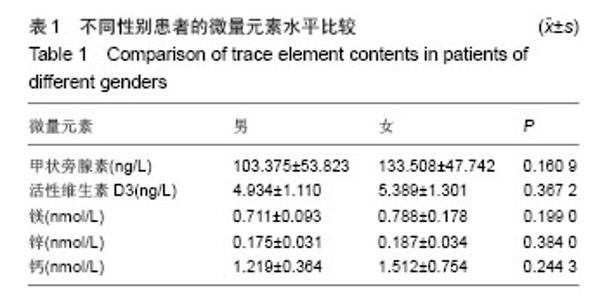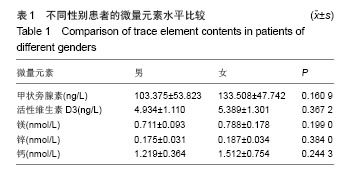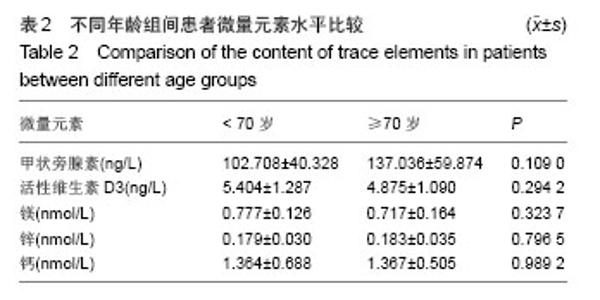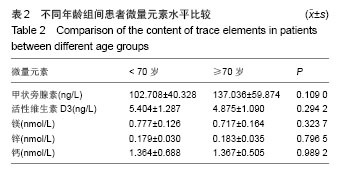Chinese Journal of Tissue Engineering Research ›› 2015, Vol. 19 ›› Issue (17): 2677-2682.doi: 10.3969/j.issn.2095-4344.2015.17.010
Previous Articles Next Articles
Correlation of trace elements and bone fusion surrounding hip prosthesis
Fu Xiao-dong, Wang Wei-li, Shen Yi, Li Xiao-miao
- Department of Orthopedics, Renji Hospital, School of Medicine, Shanghai Jiao Tong University, Shanghai 200127, China
-
Online:2015-04-23Published:2015-04-23 -
Contact:Wang Wei-li, Chief physician, Professor, Department of Orthopedics, Renji Hospital, School of Medicine, Shanghai Jiao Tong University, Shanghai 200127, China -
About author:Fu Xiao-dong, Master, Department of Orthopedics, Renji Hospital, School of Medicine, Shanghai Jiao Tong University, Shanghai 200127, China -
Supported by:the Health Science and Technology Project of Pudong New District Health Bureau, No. PW2012D-2
CLC Number:
Cite this article
Fu Xiao-dong, Wang Wei-li, Shen Yi, Li Xiao-miao. Correlation of trace elements and bone fusion surrounding hip prosthesis[J]. Chinese Journal of Tissue Engineering Research, 2015, 19(17): 2677-2682.
share this article
| [1]Caton JH, Prudhon JL, Ferreira A, et al. A comparative and retrospective study of three hundred and twenty primary Charnley type hip replacements with a minimum follow up of ten years to assess wether a dual mobility cup has a decreased dislocation risk. Int Orthop. 2014; 38(6): 1125-1129.
[2]Nakashima Y, Sato T, Yamamoto T, et al. Results at a minimum of 10 years of follow-up for AMS and PerFix HA-coated cementless total hip arthroplasty: impact of cross-linked polyethylene on implant longevity. J Orthop Sci. 2013;18(6):962-968.
[3]Landor I, Vavrík P, Jahoda D, et al. Long-term experience with the combined ARBOND hydroxyapatite coating in implant osteointegration. Acta Chir Orthop Traumatol Cech. 2009; 76(3): 172-178.
[4]Bidwell JP, Alvarez MB, Hood M Jr, et al. Functional impairment of bone formation in the pathogenesis of osteoporosis: the bone marrow regenerative competence. Curr Osteoporos Rep. 2013;11(2):117-125.
[5]Stroncek DF, Sabatino M, Ren J, et al. Establishing a bone marrow stromal cell transplant program at the National Institutes of Health Clinical Center. Tissue Eng Part B Rev. 2014;20(3) :200-205.
[6]沈奕,李晓淼,傅晓东,等.股骨近端Stro-1+细胞与骨形态发生蛋白及其受体的相关性[J].中国组织工程研究, 2012,16(45): 8380-8384.
[7]Zofková I, Nemcikova P, Matucha P. Trace elements and bone health. Clin Chem Lab Med. 2013;51(8):1555-1561
[8]Vignon E, Valat JP, Rossignol M, et al. Osteoarthritis of the knee and hip and activity: a systematic international review and synthesis (OASIS).Joint Bone Spine. 2006;73(4): 442-455.
[9]Caviglia HA, Osorio PQ, Comando D. Classification and diagnosis of intracapsular fractures of the proximal femur. Clin Orthop Relat Res. 2002;(399):17-27.
[10]柳向东,柴冈,李东,等,成人骨髓间充质干细胞的体外培养和表型鉴定[J].上海第二医科大学学报,2004,4(24):300-301.
[11]Semenowicz J, Mroczka A, Kajzer A, et al. Total hip arthroplasty using cementless avantage cup in patients with risk of hip prosthesis instability. Ortop Traumatol Rehabil. 2014;16(3):253-263.
[12]Gallo J, Vaculova J, Goodman SB, et al. Contributions of human tissue analysis to understanding the mechanisms of loosening and osteolysis in total hipreplacement. Acta Biomater. 2014;10(6):2354-2366.
[13]Cappariello A, Maurizi A, Veeriah V, et al. The Great Beauty of the osteoclast. Arch Biochem Biophys. 2014;558:70-78.
[14]Zaidi M, Moonga BS, Huang CL.Calcium sensing and cell signaling processes in the local regulation of osteoclastic bone resorption. Biol Rev Camb Philos Soc. 2004;79(1): 79-100.
[15]Rocque BG, Kelly MP, Miller JH, et al. Bone morphogenetic protein-associated complications in pediatric spinal fusion in the early postoperative period: an analysis of 4658 patients and review of the literature.J Neurosurg Pediatr. 2014;14(6): 635-643.
[16]Carreira AC, Alves GG, Zambuzzi WF, et al. Bone Morphogenetic Proteins: structure, biological function and therapeutic applications. Arch Biochem Biophys. 2014;561: 64-73.
[17]Marini JC, Reich A, Smith SM. Osteogenesis imperfecta due to mutations in non-collagenous genes: lessons in the biology of bone formation. Curr Opin Pediatr. 2014;26(4):500-507.
[18]赵益峰,王海滨,孟纯阳,等.节段性骨缺损修复过程中几种微量元素含量的研究[J].实用骨科杂志, 2010,16(2):113-117.
[19]Anné J, Edwards NP, Wogelius RA, et al. Synchrotron imaging reveals bone healing and remodelling strategies in extinct and extant vertebrates. J R Soc Interface. 2014;11(96): 20140277.
[20]Engh CA, Mcauley JP, Sychterz CJ, et al. The accuracy and reproducibility of radiographic assessment of stresss-shielding. J Bone Joint Surg (Am). 2000; 82(10): 1414-1420.
[21]Weinans H, Sumner DR, Igloria R, et al. Sensitivity of periprosthetic stress- shielding to load and the bone density-modulus relationship in subject-specific finite element models. J Biomech.2000; 33(7):809-817.
[22]Cohen B, Rushton N. Accuracy of DEXA measurement of bone mineral density after total hip arthroplasty. J Bone Joint Surg Br.1995;77(3):479-483.
[23]Hasegawa T, Hongo H, Sasaki M, et al. Biological function of bone cells on the PTH-driven anabolic effect. Clin Calcium. 2012;22(3):373-379.
[24]Aslan D, Andersen MD, Gede LB, et al. Mechanisms for the bone anabolic effect of parathyroid hormone treatment in humans. Scand J Clin Lab Invest. 2012;72(1):14-22.
[25]Kurabayashi M. Bone and calcium update; diagnosis and therapy of bone metabolism disease update. Calcification of atherosclerotic plaques: mechanism and clinical significance. Clin Calcium. 2011;21(12):43-50.
[26]Goltzman D, Hendy GN, White JH. Vitamin D and its receptor during late development. Biochim Biophys Acta. 2015;1849(2):171-180.
[27]Calvo MS, Tucker KL.Is phosphorus intake that exceeds dietary requirements a risk factor in bone health? Ann N Y Acad Sci. 2013;1301:29-35.
[28]Takeda E, Yamamoto H, Yamanaka-Okumura H, et al. Increasing dietary phosphorus intake from food additives: potential for negative impact on bone health. Adv Nutr. 2014; 5(1):92-97.
[29]Calvo MS, Moshfegh AJ, Tucker KL. Assessing the health impact of phosphorus in the food supply: issues and considerations. Adv Nutr. 2014;5(1):104-113.
[30]Cândido FG, Bressan J. Vitamin D: link between osteoporosis, obesity, and diabetes? Int J Mol Sci. 2014;15(4):6569-6591.
[31]Cranney A, Horsley T, O'Donnell S, et al. Effectiveness and safety of vitamin D in relation to bone health. Evid Rep Technol Assess (Full Rep). 2007;(158): 235.
[32]Chung M, Balk EM, Brendel M, et al. Vitamin D and calcium: a systematic review of health outcomes. Evid Rep Technol Assess (Full Rep). 2009;(183):420.
[33]Lani A, Kourkoumelis N, Baliouskas G, et al. The effect of calcium and vitamin D supplementation on osteoporotic rabbit bones studied by vibrational spectroscopy. J Biol Phys. 2014.
[34]Kemi VE, Kärkkäinen MU, Karp HJ, et al. Increased calcium intake does not completely counteract the effects of increased phosphorus intake on bone: an acute dose-response study in healthy females. Br J Nutr. 2008;99(4):832-839.
[35]Gilaberte Y, Aguilera J, Carrascosa JM, et al. Vitamin D: evidence and controversies. Actas Dermosifiliogr. 2011; 102(8): 572-588.
[36]Souberbielle JC, Maruani G, Courbebaisse M. Metabolism and main effects of vitamin D. Presse Med. 2013;42(10): 1343-1350.
[37]Leccia MT. Skin, sun exposure and vitamin D: facts and controversies. Ann Dermatol Venereol. 2013;140(3):176-182.
[38]Frost HM. From Wolff's law to the Utah paradigm: insights about bone physiology and its clinical applications. Anat Rec. 2001;262(4):398-419.
[39]Aldinger PR, Sabo D, Pritsch M, et al. Pattern of periprosthetic bone remodeling around stable uncemented tapered hip stems: a prospective 84-month follow-up study and a median 156-month cross-sectional study with DXA. Calcif Tissue Int. 2003;73(2):115-121.
[40]Venesmaa PK, Kröger HP, Miettinen HJ, et al. Monitoring of periprosthetic BMD after uncemented total hip arthroplasty with dual-energy X-ray absorptiometry--a 3-year follow-up study. J Bone Miner Res. 2001;16(6):1056-1061. |
| [1] | Yang Weiqiang, Ding Tong, Yang Weike, Jiang Zhengang. Combined variable stress plate internal fixation affects changes of bone histiocyte function and bone mineral density at the fractured end of goat femur [J]. Chinese Journal of Tissue Engineering Research, 2021, 25(6): 890-894. |
| [2] | Xu Shaoce, Wang Shiyao, Zhou Jianwei, Pan Yixin, Wang Yuliang. Fibroblast growth factor receptor 3 regulation and mechanism in callus formation [J]. Chinese Journal of Tissue Engineering Research, 2020, 24(7): 1083-1088. |
| [3] | Zhang Yanan, Yan Xia, Meng Zengdong. Zn and Mg increase the bioactivity and osteogenic induction of hydroxyapatite biomaterial in bone repair: clinical application and mechanism [J]. Chinese Journal of Tissue Engineering Research, 2020, 24(4): 606-611. |
| [4] | Zhao Qiao, Yang Fei, Zhang Chengdong, Chen Shuo, Sun Xiao, Zhang Bo, Xiao Dongqin, Liu Kang, Feng Gang, Duan Ke. Zinc ion concentration affects proliferation and osteogenic differentiation of rabbit bone marrow mesenchymal stem cells [J]. Chinese Journal of Tissue Engineering Research, 2020, 24(19): 2985-2990. |
| [5] | Song Chao1, Tian Xin1, Liu Lin1, Xu Yawen1, Meng Yuan1, Li Xiaoli1, Peng Meng2, Li Huadong2, Wang Zhitao3, Ge Sha1. Application of 25-question Geriatric Locomotive Function Scale combined with bone mineral density test in screening locomotive syndrome and risk of falls in the elderly: a survey of 1 458 people from 6 urban communities in Tianjin [J]. Chinese Journal of Tissue Engineering Research, 2019, 23(7): 990-995. |
| [6] | Li Miaomiao, Luo Jiong, Zhang Tingran, Ouyang Yiyi, Zhou Chenglin. Bone metabolism and exercise training: bone remodeling and osteoblast proliferation [J]. Chinese Journal of Tissue Engineering Research, 2019, 23(34): 5544-5549. |
| [7] | Jia Bingshen, Zhang Ximing, Yu Peng, Li Ming, Li Jun, Yun Dake, Wang Sheng, Hu Shuai. Effect of icariin on the repair of femoral defects in rabbits by calcium phosphate bone cement/bone marrow mesenchymal stem cell complex [J]. Chinese Journal of Tissue Engineering Research, 2019, 23(30): 4757-4762. |
| [8] | Zhang Yuantong. Body composition and bone mineral density of juvenile basketball players versus ordinary middle school students: data from a middle school [J]. Chinese Journal of Tissue Engineering Research, 2019, 23(3): 341-347. |
| [9] | Xie Zhong, Yang Mingzhi, Xue Jingbo, Chen Yong, Peng Lijun, Cai Bin, Zhang Yangyang. Antibacterial properties of biodegradable zinc alloys in vivo [J]. Chinese Journal of Tissue Engineering Research, 2019, 23(14): 2196-2201. |
| [10] | Peng Jie1, Luo Jiong2, Song Gang2. Eccentric exercise training against aging: problems in physiological benefits [J]. Chinese Journal of Tissue Engineering Research, 2019, 23(11): 1774-1780. |
| [11] | Feng Li-ping, Yang Wei-qiang, Ding Tong, Zhang Fu-mei, Jiang Zhen-gang, Wang Pei-shan. Imaging and histological changes of the healing process of experimental sheep femoral fracture using different fixation methods [J]. Chinese Journal of Tissue Engineering Research, 2018, 22(7): 1066-1071. |
| [12] | Yang Ben, He Dong-ning, Qin Bo-heng, Zhang Bao-ping. Preparation and performance properties of functionalized multi-walled carbon nanotubes/chitosan-zinc composite scaffolds [J]. Chinese Journal of Tissue Engineering Research, 2018, 22(6): 889-895. |
| [13] | Deng Hong. Correlation analysis of the bone mass and nutritional status of 30-49-year-old female teachers in Guangzhou [J]. Chinese Journal of Tissue Engineering Research, 2018, 22(4): 499-504. |
| [14] | Ma Tao, Li Jian, Jin Jia-peng . Effects of different sports events on bone mineral density in the recent decade: a bibliometric analysis [J]. Chinese Journal of Tissue Engineering Research, 2018, 22(4): 631-634. |
| [15] | Weng Zijing, Huang Xuejing, Yu Jianli, Zhang Minguang. Significance of routine magnetic resonance imaging examination in evaluating osteoporosis of the lumbar spine [J]. Chinese Journal of Tissue Engineering Research, 2018, 22(35): 5667-5673. |
| Viewed | ||||||
|
Full text |
|
|||||
|
Abstract |
|
|||||





